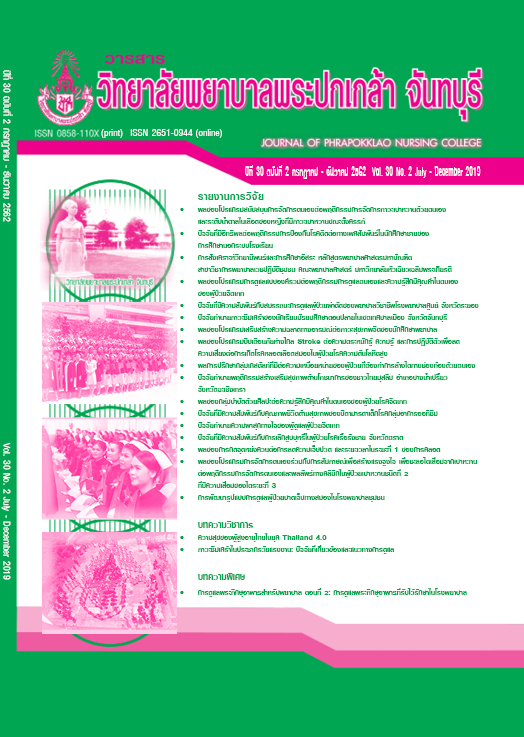The Effect of Acupressure at Yongquan Point to Relief Pain and Duration of the First Stage of Labour
Keywords:
Relief pain, Duration of labour, Acupressure, Yongquan pointAbstract
This clinical trial research aimed to examine the effect of acupressure at Yongquan point to relief pain and duration of the first stage of labour. The subjects consisted of 82 first-time pregnant women who were in labor at Mahasarakham Hospital and were equally divided into an experimental group (n = 41) and a control group (n = 41). The research instruments were composed of a pressure algometer, a data collection form, and a visual analogue scale for pain. The implementation and data collection were conducted from November, 2014 to August, 2015. Statistics used for data analysis included frequency, percentage, mean, standard deviation, repeated measures ANOVA, and independent t-test.
The research results revealed that 1) at pre-test, 5-minute post-test, and 30-minute post-test period, the mean scores of pain of experimental group were not statistically significant different; 2) at 30-minute post-test period, the experimental group had statistically significant lower mean score of pain than the control group (t = 5.332, p < .001); and 3) the mean duration of the first stage of labour of the experimental group and the control group were not statistically significant different.
This research suggests that labour nurses should apply this acupressure technique at Yongquan point as a guideline for pregnant women caring in order to reduce labour pain and duration of labour.
References
ธนาพร กิตติเสนีย์, เอมพร รตินธร, ฉวีวรรณ อยู่สำราญ, และสมชัย โกวิทเจริญกุล. (2555). ผลของการกดจุด LI 4 และ SP 6 ต่อความเจ็บปวดในระยะที่หนึ่งของการคลอดในผู้คลอดครรภ์แรก. วารสารการส่งเสริมสุขภาพและอนามัยสิ่งแวดล้อม, 35(3), 68-77.
นิภาพรรณ มณีโชติวงค์, ปราณี ธีรโสภณ, และสมจิตร เมืองพิล. (2555). ผลของการนวดกดจุดสะท้อนที่เท้า ต่อเวลาในระยะที่ 1 ของการคลอดในผู้คลอดครรภ์แรก. วารสารพยาบาลศาสตร์และสุขภาพ, 35(3), 10-18.
ปาณิสรา ไชยวงศา, สร้อย อนุสรณ์ธีรกุล, และวิชัย อึงพินิจพงศ์. (2551). ผลของการกดจุดเหอกู่ด้วยคลิปกดจุดต่อความรู้สึกเจ็บครรภ์ของผู้คลอดครรภ์แรกในระยะที่หนึ่งของการคลอด. วารสารพยาบาลศาสตร์และสุขภาพ, 31(4), 38-47.
พิริยา ศุภศรี. (2551). การพยาบาลในระยะคลอด. ศูนย์สื่อเสริมกรุงเทพ.
ลือชา วนรัตน์, ทัศนีย์ ฮาซาไนน์, และเย็นจิตร เตชะดำรงสิน. (2551). การฝังเข็ม รมยา เล่ม 1. กรุงเทพฯ: สำนักงานกิจการโรงพิมพ์ องค์การสงเคราะห์ทหารผ่านศึกในพระบรมราชูปถัมภ์.
วรรณชนก จันทชุม. (2545). การวิจัยทางการพยาบาล: การเลือกตัวอย่างและการกำหนดขนาดตัวอย่าง. ภาควิชาการศึกษาวิจัยและบริหารการพยาบาล คณะพยาบาลศาสตร์ มหาวิทยาลัยขอนแก่น.
ศศิธร พุมดวง. (2548). อุปสรรคและปัญหาการลดปวดในระยะคลอด. สงขลานครินทร์เวชสาร, 23(1), 53-59.
ศศิธร พุมดวง. (2552). การลดปวดในระยะคลอดโดยไม่ใช้ยา (พิมพ์ครั้งที่ 4). สงขลา: โรงพิมพ์อัลลายด์เพรส.
ศิริพร พงษ์โภคา, อรนุช เชาว์ปรีชา, ชลดา จันทร์ขาว, และพรทิพย์ ชีวะพัฒน์. (2552). การพยาบาลมารดาในระยะคลอด (พิมพ์ครั้งที่ 2). กรุงเทพฯ: บางกอกบล็อก.
สินีนาฏ หงษ์ระนัย, และอรุณี พึ่งแพง. (2554). การใช้เทคนิคการบรรเทาปวดโดยไม่ใช้ยาในระยะที่หนึ่งของการคลอด: การใช้ผลงานวิจัย. กรุงเทพฯ: มิสเตอร์ ก๊อปปี๊.
สุกัญญา ปริสัญญกุล, และนันทพร แสนศิริพันธ์. (2553). การพยาบาลสตรีในระยะคลอด (พิมพ์ครั้งที่ 2). เชียงใหม่: นันทพันธ์ปริ้นติ้ง.
อภิรัช อินทรางกูร ณ อยุธยา. (2554). ความรู้เบื้องต้น การพยาบาลผดุงครรภ์ เล่ม 2 (ระยะคลอดและระยะหลังคลอด). เชียงใหม่: ครองช่างพริ้นติ้ง.
Betts, D. (1998). Acupressure techniques for use during childbirth and pregnancy. Retrieved from https://www.childbirthsolutions.com/articles/birth/acupressure/index.php
Betts, D. (2003). Natural pain relief techniques for childbirth using acupressure promoting a natural labour and partner involvement. Retrieved from https://home.clear.net.nz/pages/debra_betts
Chang, S. H., Fang, M. C., & Yang, Y. S. (2010). Effectiveness of transcutaneous electrical acupoint stimulation for improving depressive mood status among nursing home elders in Taiwan: A pilot study. Geriatric Nursing, 31(5), 324-330.
Dick-Read, G. (1984). Childbirth without fear: The original approach to natural childbirth (5th ed.). New York: Harper & Row.
Hajiamini, Z., Masoud, S. N., Ebadi, A., Mahboubh, A., & Matin, A. A. (2012). Comparing the effects of ice massage and acupressure on labor pain reduction. Complementary Therapies in Clinical Practice, 18(3), 169-172.
Hjelmstedt, A., Shenoy, S. T., Victorin, E. S., Lekander, M., Bhat, M., Balakumaran, L., & Inchauspe, A. (2010). Traditional Chinese medicine K1 Yongquan and resuscitation: Another kind of “Lazarus phenomenon”. Resuscitation, 81(4), 505-506.
Lacourt, T. E., Houtveen, J. H., & van Doornen, L. J. P. (2012). Experimental pressure-pain assessments: Test-retest reliability, convergence and dimensionality. Scandinavian Journal of Pain, 3(1), 31-37.
Ma, W., Bai, W., Lin, C., Zhou, P., Xia, L., Zhao, C., … Lu, A. (2011). Effects of Sanyinjiao (SP6) with electroacupuncture on labour pain in women during labour. Complementary Therapies in Medicine, 19(Suppl. 1), 13-18.
Melzack, R., & Wall, P. D. (1996). Pain mechanisms: A new theory. Pain Forum, 5(1), 3-11.
Nilsson, C., Lundgren, I., Karlstrom, A., & Hildingsson, I. (2012). Self reported fear of childbirth and its association with women’s birth experience and mode of delivery: A longitudinal population-based study. Women and Birth, 25(3), 114-121.
Strudwick, M. W., McMahon, K. L., & Choy, S. T. (2007). Rapid response of autonomic nervous system to acupuncture in subjects under stress. Australian Journal of Acupuncture and Chinese Medicine, 2(1), 9-15.
Downloads
Published
How to Cite
Issue
Section
License
Copyright (c) 2019 JOURNAL OF PHRAPOKKLAO NURSING COLLEGE

This work is licensed under a Creative Commons Attribution-NonCommercial-NoDerivatives 4.0 International License.
เนื้อความ ข้อมูล และรายการอ้างอิงที่ผู้เขียนใช้ในการเขียนบทความเพื่อลงตีพิมพ์ในวารสารวิทยาลัยพยาบาลพระปกเกล้า จันทบุรี ถือเป็นความคิดเห็นและความรับผิดชอบของผู้เขียน คณะผู้จัดทำวารสารไม่จำเป็นต้องเห็นพ้องด้วยหรือร่วมรับผิดชอบ
บทความที่ได้รับการลงตีพิมพ์ในวารสารวิทยาลัยพยาบาลพระปกเกล้า จันทบุรี ถือเป็นลิขสิทธิ์ของวารสารวิทยาลัยพยาบาลพระปกเกล้า จันทบุรี หากหน่วยงานหรือบุคคลใดต้องการนำส่วนหนึ่งหรือทั้งหมดของบทความไปเผยแพร่ต่อเพื่อวัตถุประสงค์ใด ๆ จะต้องได้รับอนุญาตจากบรรณาธิการวารสารก่อน



